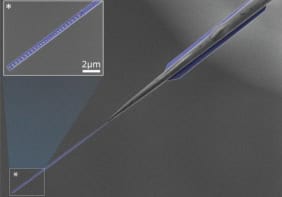A central assumption of fluid dynamics is that liquid particles in contact with the walls of a vessel stay put while the rest of the liquid flows past. But Vincent Craig and colleagues at the Australian National University in Canberra have shown that this 'non-slip boundary condition' leads to inaccurate predictions of how fluids behave in small systems. The discovery may help to explain how blood flows through capillaries, and could improve the design of lubricants for nanomachines (V Craig et al 2001 Phys. Rev. Lett. 87 054504-1).
Most fluid-dynamics simulations based on the non-slip boundary condition produce good results on large scales. However, previous experiments with capillary tubes have hinted that the molecules in contact with the vessel wall do move, and that this effect may become important at small scales. To test this hypothesis, Craig and colleagues studied a solution of sugar and water. This is a ‘perfect’ or Newtonian liquid, which means that its viscosity increases as a greater shear force is applied.
The team immersed a mica sheet and a silica sphere 20 micrometres in diameter in the solution. A very fine spring connected the sphere to an atomic force microscope, which measured the force on the sphere as the mica surface was pushed towards it. When the distance between the sphere and the surface was less than the radius of the sphere, Craig and colleagues found that the motion of molecules in contact with the surface and with the sphere became important.
Craig’s team modified an existing relationship to account for the effect of this slip on the force experienced by the sphere. This allowed them to calculate that the molecules at the solid-fluid interface shifted by up to 20 nanometres as the liquid flowed through the progressively narrower channel between the sphere and the surface. Craig and co-workers found that this ‘slip distance’ is related to the viscosity of the fluid and the velocity of the sphere.
This discovery helps to explain why red blood cells can squeeze through narrow capillaries without placing too much pressure on the capillary walls. Ink-jet printers and other micro- and nanomachines should also benefit from the improved understanding of how fluids behave in closed systems.
“The occurrence of slip in aqueous Newtonian fluids considerably complicates flow predictions in confined systems”, says Craig. “But this is the price that must be paid for accurate modelling”.



